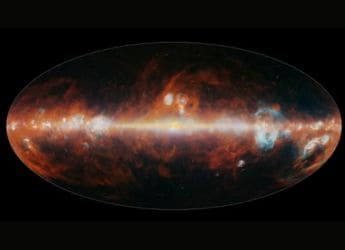- Home
- Science
- Science News
- NASA's New Horizons to Fly Past Ultima Thule Tonight, Here's How to Watch
NASA's New Horizons to Fly Past Ultima Thule Tonight, Here's How to Watch

Photo Credit: NASA/JHUAPL/SwR
To ancient explorers, "Ultima Thule" was what lay past the northernmost edges of maps, beyond the borders of the known world.
So when NASA chose a target for its New Horizons spacecraft that was farther than anything explored before, "Ultima Thule" seemed a fitting moniker. The far-flung space rock is an inhabitant of the Kuiper Belt, the ring of debris that encircles the icy outer reaches of solar system.
Ultima Thule is so dim and so distant that scientists aren't even certain what it looks like. Some of their only information about its size and shape comes from a series of coordinated observations last summer, when astronomers measured the shadow it cast as it passed in front of a star.
But New Horizons will finally fly by its target just after midnight on January 1, taking close-up photographs and sophisticated scientific measurements of what it sees. By the time the first images and data stream back to Earth, the borders of the known world will have expand once more.
"This is just raw exploration," said Alan Stern, a scientist at the Southwest Research Institute and the principal investigator for the mission. "No one has ever seen a Kuiper Belt object as anything but a point of light. No one has ever seen an object that's frozen almost to absolute zero. There are a lot ideas and every one of them might be wrong."
He took a breath. "We'll find out Tuesday."
NASA is celebrating the record-setting encounter with the solar system's nerdiest New Year's party. At the Johns Hopkins University Applied Physics Laboratory, which built and operates the spacecraft, scientists will count down to the moment of New Horizons' closest approach, at 12:33am. Eastern, then reconvene 10 hours later to watch first signals from the flyby stream onto their screens. (It takes more than six hours for light to travel from Ultima Thule back to Earth.) NASA's vaunted social media operation, which had fallen silent during the partial government shutdown, has been temporarily restored to cover the event. The countdown, signal acquisition and subsequent news conferences will be streamed live on NASA TV and YouTube.
Alice Bowman, New Horizons' mission operations manager at APL, said the spacecraft entered "encounter mode" on Wednesday. This configuration limits the spacecraft's communication with Earth, commanding it to quickly address any technical issues on its own, then get back to science. Though nerve-wracking for engineers, encounter mode ensures that New Horizons makes the most of its brief time near Ultima Thule.
"Because this is a flyby, we only get one chance to get it right," Bowman said.
New Horizons left Earth in January 2006; it was the first mission designed to explore the most distant part of the solar system. Nine years and 3.5 billion miles later, it took the first-ever close up photos of Pluto, revealing a complex and colorful world mottled with methane mountains and a vast, heart-shaped nitrogen ice plain.
After that flyby, Stern and his colleagues set about searching for a new target in the Kuiper Belt, which extends from the edge of Neptune's orbit out to about 5 billion miles from the sun.
Until the 1990s, no one knew what hid out here, where sunlight is 0.05 as faint as it is on Earth. Now, the Kuiper Belt is thought to include millions of icy objects, unused planetary building blocks left over from the earliest days of the solar system. These bodies are time capsules, preserved in a deep freeze for the past 4.6 billion years. NASA says Ultima Thule is likely the most primitive planetary object ever explored.
The Kuiper Belt object was discovered with the Hubble Space Telescope in 2014. Subsequent observations suggest it is small - no more 20 miles across - and peanut shaped. Astronomers believe it is a contact binary, comprising two objects touching each other, or perhaps even a binary system, in which two objects are orbiting one another.
The encounter with Ultima Thule will be brief and technically demanding, even more so than New Horizons' Pluto flyby. Whereas Pluto is roughly the size of the United States, Ultima could fit atop Washington, D.C. This means New Horizons has to get much closer to the little space rock to examine it, and the encounter will be over much more quickly.
Twenty-four hours before closest approach, Ultima Thule still takes up only two pixels in images taken by New Horizons' camera screen. As New Horizons speeds through space at 9 miles per second, it will take less than a day to turn Ultima Thule back into a speck in the rear view mirror.
But New Horizons' performance so far suggests it is ready for the challenge, Stern said. Measurements taken Saturday showed that the spacecraft was within 20 miles of its intended flyby distance from Ultima Thule, and that the timing of the encounter will be within 2 seconds of what was expected.
"We're rendezvousing with something that's a mountain draped in black velvet in almost pitch dark conditions and we're screaming up to it ... within 2 seconds of perfection," Stern said. "You can't get any better than that."
Get your daily dose of tech news, reviews, and insights, in under 80 characters on Gadgets 360 Turbo. Connect with fellow tech lovers on our Forum. Follow us on X, Facebook, WhatsApp, Threads and Google News for instant updates. Catch all the action on our YouTube channel.
Related Stories
- Samsung Galaxy Unpacked 2025
- ChatGPT
- Redmi Note 14 Pro+
- iPhone 16
- Apple Vision Pro
- Oneplus 12
- OnePlus Nord CE 3 Lite 5G
- iPhone 13
- Xiaomi 14 Pro
- Oppo Find N3
- Tecno Spark Go (2023)
- Realme V30
- Best Phones Under 25000
- Samsung Galaxy S24 Series
- Cryptocurrency
- iQoo 12
- Samsung Galaxy S24 Ultra
- Giottus
- Samsung Galaxy Z Flip 5
- Apple 'Scary Fast'
- Housefull 5
- GoPro Hero 12 Black Review
- Invincible Season 2
- JioGlass
- HD Ready TV
- Laptop Under 50000
- Smartwatch Under 10000
- Latest Mobile Phones
- Compare Phones
- Huawei Nova 15
- Huawei Nova 15 Pro
- Huawei Nova 15 Ultra
- OnePlus 15R
- Realme Narzo 90x 5G
- Realme Narzo 90 5G
- Vivo S50 Pro Mini
- Vivo S50
- Asus ProArt P16
- MacBook Pro 14-inch (M5, 2025)
- Huawei MatePad 11.5 (2026)
- OnePlus Pad Go 2 (5G)
- OnePlus Watch Lite
- Just Corseca Skywatch Pro
- Acerpure Nitro Z Series 100-inch QLED TV
- Samsung 43 Inch LED Ultra HD (4K) Smart TV (UA43UE81AFULXL)
- Asus ROG Ally
- Nintendo Switch Lite
- Haier 1.6 Ton 5 Star Inverter Split AC (HSU19G-MZAID5BN-INV)
- Haier 1.6 Ton 5 Star Inverter Split AC (HSU19G-MZAIM5BN-INV)

















